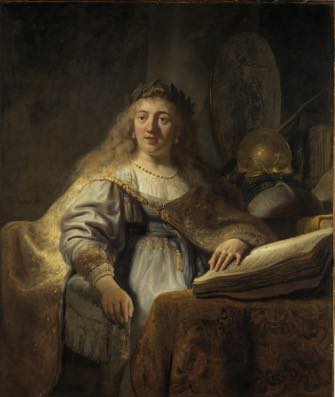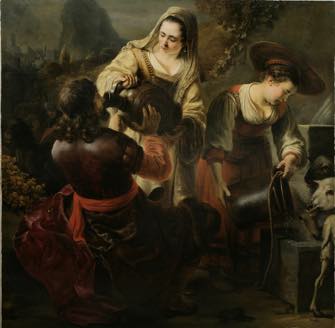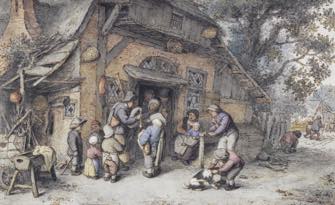
Lovers of Dutch Golden Age art – and who isn’t? – are being spoiled in Paris this season. The Louvre is hosting the blockbuster Vermeer exhibition, of course, but it is also featuring two smaller related shows that should not be missed.
“Masterpieces of the Leiden Collection” takes us to Rembrandt’s hometown through the collection of Thomas Kaplan and Daphne Recanati Kaplan. Of the 30 works loaned by the American couple, 12 are by Rembrandt, making this the largest private collection of the master’s work.
Three of them are early (1624-25) experimental allegories for the senses of touch, smell and hearing, full of expression and color, respectively depicting an operation, an unconscious woman being brought around by smelling salts, and three musicians.
More spectacular are some of the master’s larger oil paintings, notably “Minerva in her Study” (1635; pictured at top of page), one of a series the artist painted of goddesses. The proud, rather heavy-featured Minerva looks up from her reading, a laurel wreath crowning her long golden locks, which flow onto the patterned golden cloak she wears, while reflected light gleams from the golden helmet behind her.
Continuing the feast of Rembrandts are a number of portraits by him, including a self-portrait and a lovely close-up portrait of a young girl that is attributed to him. There is also a 1631 full-length portrait of the master by his student Isaac de Jouderville.
The centerpiece of this show, however, is not a Rembrandt but “Eliezer and Rebecca at the Well” (1645-46) by Ferdinand Bol, one of

Rembrandt’s students, which has been gifted to the Louvre by the Kaplans.
Among the other treasures in the show are works by Jan Steen (notably, the touching “The Benediction” [1660], showing a mother, father and baby praying before breaking bread, seated next to a window – although the figures

are rather stiff, this work exudes a Vermeer-like sense of meditative calm), Jan Lievens (including a beautiful self-portrait of him in his early 20s in which he looks like a

Romantic poet and the portrait of a young man in a cape and turban that adorns the poster).
Downstairs, the show “Drawing the Everyday” offers a delightful peek at life in 17th-century Holland as drawn by many of the great masters of the period, including, of course, Rembrandt again.
It is hard to decide which are more fascinating and charming: masterly, almost minimalist works by Rembrandt like “Woman at a

Window” or such detailed depictions of everyday scenes as Adriaen van Ostade’s watercolor “Bagpipe Player in Front of an Inn,”

With nearly 100 works in this show, you may not be able to study each one carefully, but it may well be worth going back to try.
If you can’t get enough of the Old Masters (and how could you?), the Fondation Custodia is also holding a wonderful exhibition of Dutch Golden Age studies for paintings, “Du Dessin au Tableau au Siècle de Rembrandt.”
Favorite